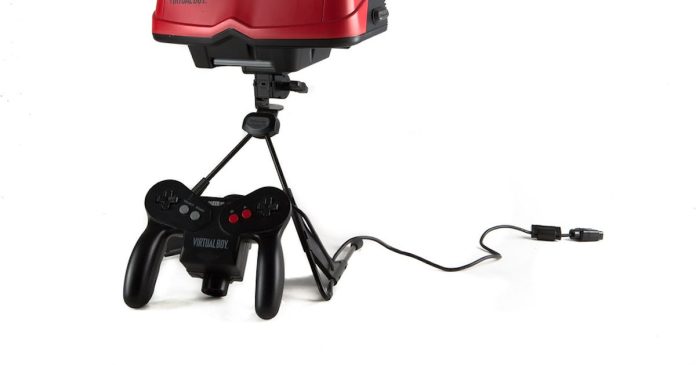In 1995, Nintendo seemingly could do no wrong. The Japanese company revitalized the gaming market in the West with a mix of clever marketing and an unprecedented string of hits that bore unforgettable franchises we know and love today. It would follow up that momentum with the Game Boy, essentially perfecting the concept of handheld gaming, and an NES successor widely considered one of the greatest consoles of all time. Even against stiff competition from Sega, Nintendo remained the international market leader in gaming’s resurgence.
So, how would a company on top of the world continue its dominance deep into the nineties? By trying to push its technology into uncharted territory. Unfortunately, while these ambitions were certainly admirable, the resulting product marked Nintendo’s first stumble in an otherwise spotless run. The Virtual Boy is a forgotten piece of Nintendo history (likely by design, as it carries the distinction of being the company’s biggest flop.) Thirty years later, this flop is a compelling look at how even the most beloved gaming companies can fly too close to the sun.
The Virtual Boy was Nintendo’s attempt to compete in the then-burgeoning virtual reality space of the 1990s. While the trend ultimately went nowhere in the long run, companies like Virtuality were looking to take computing to the next level. To match, Nintendo began steps to make its version of the technology in 1991, leveraging research from an ambitious group of technologists based in Cambridge, MA.
Mario Tennis got its start on the Virtual Boy.
Nintendo
The technology was revealed in Japan in November 1994 and in the U.S. at the 1995 CES in Las Vegas. There was excitement about a consumer-level gaming device that would incorporate tech straight out of science fiction. However, even then, the press was wary about its promise, and the blatant drawbacks of the console that proved the technology may not have been ready for showtime (more on that later).
Despite the broad reservations, hype for the console moved forward. It would launch in Japan in July 1995, and in the U.S. in August for $179.99. While the price tag was certainly an obstacle, especially for such an experimental and unproven piece of technology, Nintendo managed to give customers a sensible alternative. For just $10, gamers all over the U.S. could rent a console from Blockbuster, allowing them to try it out for themselves. For those lucky enough to give this weird idea a shot, it was immediately clear how limited Nintendo’s vision was.
Despite its grand ambitions, reality clashed hard with expectations. For one, the console’s very name was misleading. The Virtual Boy wasn’t virtual reality, but a pair of ocular screens capable of creating a 3D illusion when viewed up close. Compounding that disappointing reality was the fact that these screens could only display eye-searing red, making every single game on the console harsh on the eyes over extended periods of play. Nintendo incorporated a built-in timer to remind players to give their eyes a rest, the antithesis of fun. Defying this warning would often result in headaches and dizziness.
Virtual Boy Wario Land was one of the few excellent games on the console.
Nintendo
The issues didn’t end with the technology itself. The form factor of the system was a bit of a nightmare. The Virtual Boy wasn’t worn, but placed on a table and leaned into. This meant players had to play in a fixed position up against a mounted pair of goggles, and awkwardly hold their terrible controller underneath it. Comfort was not a priority when the Virtual Boy was designed.
Perhaps the biggest issue with the Virtual Boy was its lack of software. Of the 22 games available on the console (only 14 of which came out in America), few of them were proper showcases for the technology. Instead, the library was made up of 2D games you’d expect from the NES, except with graphics that actually hurt to look at. While the system was packed in with Mario’s Tennis, the iconic Italian plumber made scant, meaningful appearances on the console.
The only other game he’d appear in was Mario Clash, a remixed version of the original Mario Bros arcade game. Instead, Wario would be the star in the console’s best game, Virtual Boy Wario Land, a title that lived up to Nintendo’s reputation as a developer at the time, and is probably the sole Virtual Boy game worth a re-release on modern consoles.
Nintendo was ultimately just fine following the flop of the Virtual Boy, as the N64 quickly put the company back on track.
SOPA Images/LightRocket/Getty Images
For all of these reasons, the Virtual Boy ended up a big flop. It certainly didn’t help that within a month of its launch, both the PlayStation and the Sega Saturn would release, burying in the headlines what little appeal this experimental console had. It sold poorly, managing 770,000 units sold worldwide, far below the expected 3 million Nintendo had projected. Less than a year after release, rather than keep the charade going, Nintendo cut its losses and discontinued support for it altogether.
The Virtual Boy doesn’t have a whole lot of redeeming qualities. It’s where the Mario Tennis franchise would get its humble start. The aforementioned Wario Land game is pretty great, a pioneering 2D side-scroller with multiple planes to explore. But even Nintendo seems to want to forget the whole thing happened. Ultimately, the company was just fine. Just a few months after admitting defeat with the Virtual Boy, the Nintendo 64 launched alongside Super Mario 64. The rest, of course, is history.
But while the Virtual Boy feels deeply forgotten 30 years later, it’s also a fun and obscure piece of Nintendo lore. Seeing the shortcomings and head-scratching decisions made with the Virtual Boy feels alien against the company’s Disney-esque stature today. It’s proof that even when riding on the highest of highs, nobody is immune to the threat of bad ideas.
